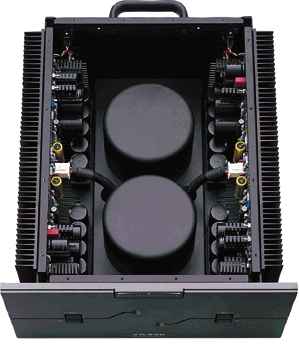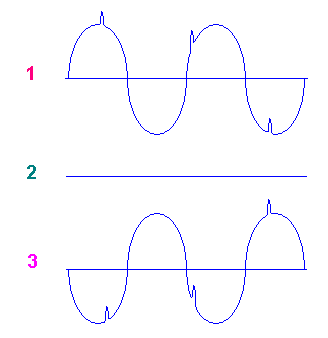John E. Johnson, Jr.

|
Balanced Audio Technology VK-500 Two channel Power Amplifier 250 Watts RMS Per Channel into 8 Ohms, 450 Watts Per Channel into 4 Ohms THD < 1 % at Full Output Input Impedance: 100 kOhms Slew Rate: > 300 V/µ sec Output Impedance: 0.2 Ohms Size: 9 1/2"H x 19"W x 23"D Weight: 105 Pounds MSRP: $5,000 for Basic Model, or $5,800 with Additional Power Supply Storage (BAT-PAK) |
| Balanced Audio Technology Inc., 26 Beethoven Drive, Wilmington Delaware 19807; Phone 302-999-8855 ; Fax 302-999-8818; E-Mail [email protected]; Web http://www.balanced.com. |
Introduction
I know, I know, this is a lot of money for an amplifier, but after having reviewed the phenomenal Balanced Audio VK-5i Tube Preamplifier, I just had to see if their solid state power amplifier was as good. So, I requested the VK-500 Stereo Power Amplifier (VK stands for Victor Khomenko, the designer). Having mentioned so many times that the power supply is critical to amplifier performance, I asked for the "BAT-PAK", which brings the total energy storage to 1,100 Joules (350 Joules is the standard supply, which is still quite a bit). BAT told me that most of their VK-500s are sold with the BAT-PAK. The VK-500 is a dual mono design, meaning that it has separate power cords, toroidal transformers, power supply capacitors, and main circuitry. Dual mono designation is the same thing as monoblocks, except that the dual mono amplifier has everything in one chassis instead of two separate chassis. For the power supply, 550 Joules are assigned to each channel, with the BAT-PAK. The front panel has two on/off switches (one for each channel) and two blue LEDs for power-on indication. The rear panel has two XLR balanced input jacks, two pairs of gold plated heavy duty five way speaker binding posts, and detachable grounded AC input jacks. Heat sinks extend on either side of the chassis. A large handle on the rear allows lifting this very heavy amplifier like a suitcase.
Circuits
In keeping with trends, the VK-500 utilizes
toroids rather than EI core transformers. For the same size, toroids
have more power capability than EI core transformers, but are
more costly. The toroids in the VK-500 are magnetically shielded
and covered with aluminum cans. Covering the transformer slows
down the heat dissipation, but magnetic shielding will reduce
interaction of the transformer's magnetic field with nearby circuits.
 The VK-500 uses a multitude of small capacitors
rather than just a few large ones. This reduces series inductance,
and anytime you can reduce reactance that you don't want in the
circuit, deterioration of the signal is also reduced. The circuit
boards are beautifully laid out inside the chassis, with each
board essentially a mirror image of the other.
The VK-500 uses a multitude of small capacitors
rather than just a few large ones. This reduces series inductance,
and anytime you can reduce reactance that you don't want in the
circuit, deterioration of the signal is also reduced. The circuit
boards are beautifully laid out inside the chassis, with each
board essentially a mirror image of the other.
Most amplifiers have between three and five gain (amplification) stages. Let's say an amplifier has five. Three of these would typically be part of the input section, one would be a driver (buffer) stage between the input section and the output section, and the fifth stage would be the output section. The input stage(s) are used for voltage amplification, the buffer stage interfaces between the input section and the output section, and the output stage is for current amplification.
The VK-500 has only two gain stages, an input stage and the output stage. The input stage serves as the driver for the output stage. As a result, the input stage has to be run at very high bias, meaning high current, and therefore, high heat. Indeed, the amplifier gets very warm during use, whether at idle or at high output. So, before you even get to the output, there are considerable demands on the power supply, and that is one reason why there is such a big supply on the VK-500, even with the basic model (the one without the BAT-PAK). Now, most manufacturers could build an amplifier with only two stages, but it is difficult and expensive, because part of the procedure means having a huge power supply, and the power supply is the most expensive part of the amplifier. As consumers, the majority of us are not willing to pay $5,000 for a stereo amplifier. But BAT has chosen to make their designs no compromise products, and from the obvious success they are having, it appears to have been a good path to take. Their idea is that, with only two gain stages, there are less interfaces (each stage has to pass through an interface to the next), and therefore, less signal deterioration occurs. Remember, one amplifier cannot "improve" the sound compared to another. Rather, one amplifier will simply degrade the original signal less than the other.
Solid state amplifiers are usually push pull with P type output devices for one side of the signal and N type devices for the other (the + and - portions of the waveform). Calculating that the N type is the faster of the two, BAT has utilized only N type MOSFETs (24 MOSFETs per channel) for both sides of the signal. This is no easy task, and has taken years of engineering to accomplish, but the payoff is a very fast amplifier (300 V/µ sec slew rate).
The VK-500 is fully balanced, meaning that,
from input to output, the signal never connects with the ground.
With unbalanced amplifiers, the negative conductor (the return
path of the signal) is also the ground.  Noise
can get into the signal path, and when it passes through to the
speakers, raises the noise floor, which reduces the ability to
reproduce low level detail in the music. Because the noise is
in phase on the positive and negative conductors, while the signal
is inverted (conductors 1 and 3 in the diagram on the left) with
a balanced signal, the noise cancels out when the signal from
the conductors is combined in the amplifier. This improves the
noise floor, giving life to low level detail. The VK-500, like
BAT's other products, has only XLR input jacks, no RCA unbalanced
jacks. If you wish to use an unbalanced input from a preamplifier,
BAT optionally supplies the RCA-XLR adapters ($90/pair).
Noise
can get into the signal path, and when it passes through to the
speakers, raises the noise floor, which reduces the ability to
reproduce low level detail in the music. Because the noise is
in phase on the positive and negative conductors, while the signal
is inverted (conductors 1 and 3 in the diagram on the left) with
a balanced signal, the noise cancels out when the signal from
the conductors is combined in the amplifier. This improves the
noise floor, giving life to low level detail. The VK-500, like
BAT's other products, has only XLR input jacks, no RCA unbalanced
jacks. If you wish to use an unbalanced input from a preamplifier,
BAT optionally supplies the RCA-XLR adapters ($90/pair).
The Sound
I tested the VK-500 with our McCormack CD system, the VK-5i Tube Preamplifier, Nordost Cables, and several sets of speakers, including the Carver Mark IV Platinums (ribbons), Osborn Eclipses (cones), and Threshold ES-500s (electrostatics). This gave me a full range of loads for the VK-500.
I was particularly interested in seeing how the VK-500 performed with the electrostatic speakers, since it has no global feedback and, as a result, a larger than typical output impedance of 0.2 Ohms. High output impedance can cause strange effects with a reactive load, such as an electrostatic speaker. All speakers are reactive, but "reactive load" refers to a speaker that has more capacitance or inductance than most speakers. I have had the VK-500 for several months, during which I allowed it to "break in".
The VK-500 has so much power and clean detail, it is difficult to know where to begin describing it. Because of the balanced design, there was absolute dead silence with everything turned on, but no music playing, with my ear right up against one of the speakers. With unbalanced designs, and such long interconnects (30 feet) between the preamp and power amp, I usually hear a slight buzzing noise with my ear against the speaker. I also have a 30 foot set of balanced interconnects (Nordost). The VK-5i preamplifier is also fully balanced, so the combination resulted in very, very low noise. The VK-500 drove the electrostatics without strain, to high SPL, and with such deep bass, that the full range electrostatic panels visibly shimmered. All the detail and transparency that electrostatics are capable of with top notch amplifiers was there. It was such a good match, I almost called a Justice of the Peace.
The Carver Platinums sang like a nightingale. Although they can have some cancellation due to the dipolar nature of their woofers, there was still so much deep bass, that I could see the liquid surface in my soft drink glass ripple. When I added a powerful subwoofer (Velodyne FSR-18 and Sunfire Signature) to the system to give me < 20 Hz response, organ tocattas almost lifted me from my easy chair.
The Osborns are perhaps the easiest loads in our lab to drive, and they sounded great with the VK-500. These floorstanding speakers have a dedicated subwoofer-like bass response, and the VK-500 showed off this capability to its best. Yet, again, the detail was all present. Massive, raw, clean power is the secret. And, by low level detail, I am referring to the subtle nuances that are in the background of the music, regardless of the volume it is being played at. The imperceptible noise floor of the VK-500 results in every nuance being there, which gives the sound more realism, more impact, more hairs on the back of the neck being raised. The presence of detail at higher SPL also means that the amplifier is not producing much distortion under stress (nor the speakers). Again, clean power with skyscraper headroom.
In summary, there are several features of the VK-500 that make it different than most other amplifiers. These are (1) an enormous power supply; (2) the fully balanced design; (3) the use of N type MOSFETs rather than P and N; and (4) having only two gain stages. Scientifically speaking, I could not say which of these features is more important than the others in making the amplifier sound so good. I would estimate, however, that number (1) is most important, followed by (4), then (2), and (3). But that is only a guess. In any case, the VK-500 has all four features, so the question is moot. In my opinion, the VK-500 is one of the finest amplifiers ever designed.
John E. Johnson, Jr.
© Copyright 1998 Secrets of Home Theater & High Fidelity
Return to Table of Contents for this Issue.

